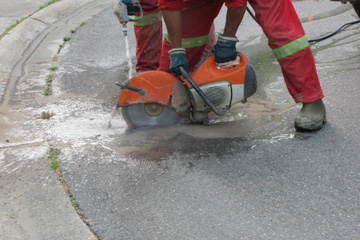- Home
- Loss Control
- Loss Control Insights
- Contractor’s Guide to Silica (updated July 2021)
In 2016, OSHA implemented silica standards that require employers to limit worker exposures to respirable crystalline silica and to take other steps to protect workers. The standard for construction (29 CFR 1926.1153) can be complicated, so this article intends to provide answers to frequently asked questions, give information about silica hazards and clarify the silica standard for contractors.
Please note that OSHA has separate silica rules for general industry or maritime work.
What Is Silica?
Crystalline silica is a chemical compound commonly found in sand, stone, concrete, brick, mortar and other materials often found in construction sites. When left undisturbed, silica does not present a hazard. However, cutting, sawing, grinding, drilling and crushing the materials mentioned above creates very small particles called respirable crystalline silica (to keep things simple, we’ll just refer to it as silica in this article).The Dangers of Silica
These tiny particles—at least 100 times smaller than ordinary sand—can easily be inhaled, presenting multiple health hazards. Silica particles can lodge themselves in the lungs where they cause disabling—and sometimes fatal—lung diseases, such as silicosis and lung cancer. Silica exposure can also cause kidney disease and chronic obstructive pulmonary disease.What is the Permissible Exposure Limit for Silica?
The permissible exposure limit (PEL) for silica is 50 micrograms of respirable crystalline silica per cubic meter of air (µg/m3), averaged over an eight-hour day. The standard also comes with an “action level” of 25 µg/m3. If your employees are exposed to 25 µg/m3 of silica or more in the air, you need to develop an exposure control program and demonstrate what you’re doing to reduce employee exposure. Here are some of the tasks that could potentially expose your employees to levels above the PEL:- Drilling, grinding or cutting concrete or stone
- Setting duct and pipe hangers into concrete
- Using jackhammers or powered chipping tools
- Tuckpointing
- Crushing concrete or stone
- Demolition of concrete or silica-containing materials
- Sanding drywall
Silica Monitoring and Hazard Control
To know exact exposure levels, you would need to conduct silica exposure monitoring for each silica-related task. This involves attaching a sampling pump to your employee. The pump pulls in air, collecting silica on a filter throughout the shift. Then, the filter is analyzed to determine the amount of silica the employee is exposed to. Depending on monitoring results, further periodic monitoring will need to be performed until exposures are below the action level.Since determining silica levels can be difficult, OSHA created a table of common tasks with silica exposures. For each listed task, OSHA identified the hazard control methods—engineering controls, work practices and respiratory protection—contractors should use to protect employees. Silica exposure monitoring is only required for situations where:
a) Employees are performing a task not listed in OSHA’s table
-OR-
b) Engineering controls, work practices and respiratory protection are not fully and properly implemented as described in OSHA’s table
How to Remove Silica Dust Safely
Anytime your employees clean up dust, they may come into contact with silica. While wet cutting and grinding methods do a great job of controlling silica dust, there will likely still be some material that needs to be cleaned up once dry. Removing with a broom or compressed air creates a potentially dangerous cloud of dust and clumping compounds still leave some airborne silica. Instead, we recommend you remove silica-containing dusts with a HEPA filtered vacuum.Fabrication and Installation Silica Hazards
Another recognized silica hazard is present in natural or manufactured stone countertops. These materials all contain silica in varying amounts, but engineered stone is especially hazardous with 90% silica—substantially more than natural stone. Engineered stone has become increasingly popular, increasing the numbers of employees who are exposed during manufacturing, finishing and installing. Many tasks in the stone fabrication and installation industry have been linked with hazardous silica exposure, including:- Cutting, grinding, polishing
- Sanding
- Gluing
- Finishing
- Cleanup/housekeeping
How to Stay in Compliance With OSHA’s Silica Standard
The easiest way to ensure you’re following OSHA’s standard is to create an action plan. Use the steps below as a starting point for your own customized plan.- Identify tasks that might expose employees to silica.
- Identify a competent person who is capable of identifying silica hazards and authorized to take prompt corrective measures to control or eliminate those hazards.
- Compare your task list to OSHA’s table. For each task listed, make sure you’re following the identified control methods, including engineering controls (e.g., wet cutting and exhaust ventilation), work practices (e.g., wetting down dust before cleaning it up) and respiratory protection (Note: using respirators to protect employees is only allowed when engineering and work practice controls are used but can’t keep exposures at or below the PEL).
- Conduct exposure monitoring for tasks not listed in the table. Follow OSHA’s methods of sample analysis and develop a program that addresses how you will control employee exposure. Highly exposed employees—those required to wear a respirator for 30 or more days per year—may need medical exams with chest X-rays and lung function tests.
- Create a written exposure control plan. Simply list the tasks you identified, the control measures and housekeeping practices you are using to protect workers and procedures you are implementing to restrict access to silica work areas.
- Train your employees to understand what work operations result in silica exposure and make sure they understand how to limit their exposure.
- Keep records of any monitoring and medical exams.
Find More Silica Safety Resources Online
Get in touch
Need help? We’re here for you! Whether you have questions or need personalized assistance, your local office is ready to support you.
Loss Control Insights
Stay informed with the latest news and receive actionable safety tips, all carefully curated by our team of experts.
